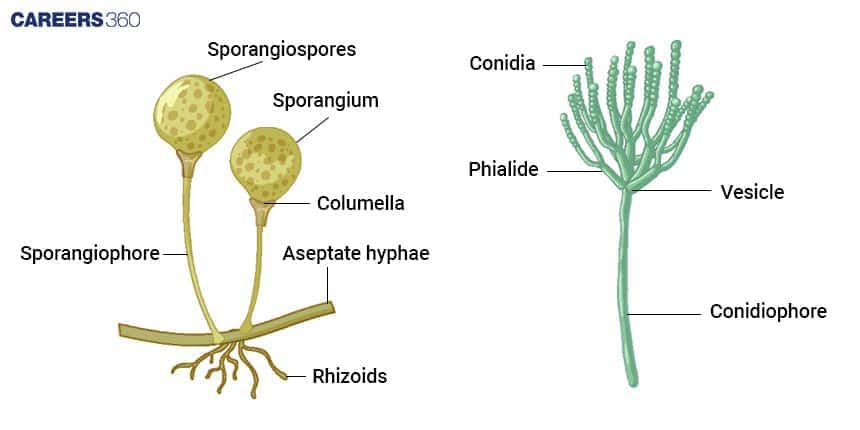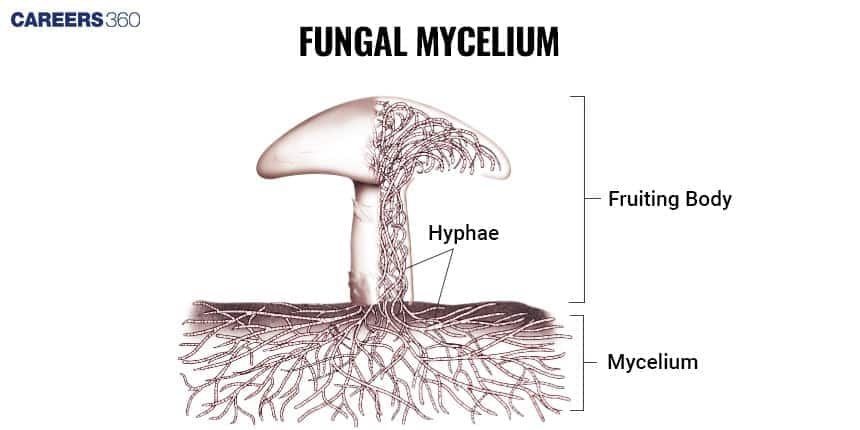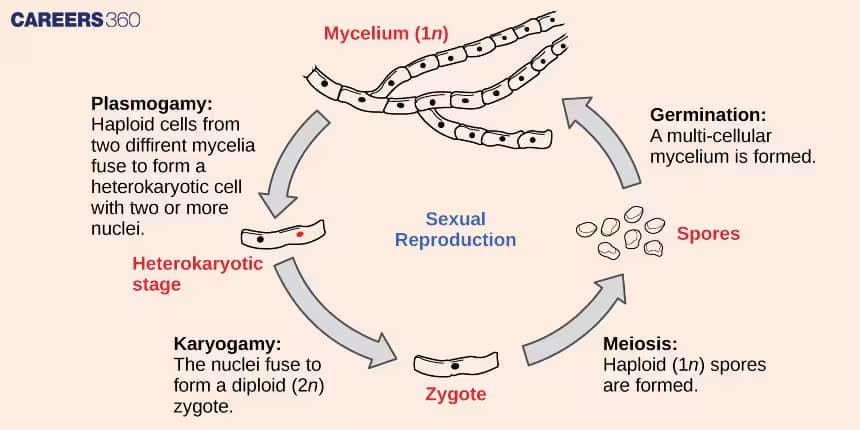Fungi Life Cycle: Introduction, Life Cycle, FAQs
Fungi are a large group of eukaryotic organisms that are vital in the ecosystem as well as in the improvement of human health. The Fungi Life Cycle typically involves spore formation, germination, mycelial growth, and either sexual or asexual reproduction. Spores are released to form new fungi, allowing them to adapt and survive in various environments.
This Story also Contains
- What are Fungi?
- Asexual Reproduction In Fungi
- Sexual Reproduction in Fungi
- Life Cycle of Fungi - Stages
- Fungi Life Cycle Diagram
.jpg)
This article on the Fungal Life Cycle includes spore formation, hyphal growth, mycelium formation, and the reproduction process. Fungi are classified into different groups based on how they reproduce and their structures. Each group has important roles in nature, and some have economic or medical uses. This is a topic of the chapter Biological Classification in Biology.
What are Fungi?
Kingdom Fungi are characterised by chitin-containing cell walls and the ability to obtain nutrients through extracellular digestion. Fungi have many forms, ranging from smaller moulds to larger mushrooms.
The common life cycle that many of them undergo includes the formation of spores, germination, hyphal growth, and reproduction either sexually or asexually; all these help them in their specific role in the ecosystem as decomposers, pathogenic organisms, or mutualistic symbionts.
It is only possible if one understands all the difficult aspects that are associated with fungi and how they interact with other organisms for him or her to be in a position to fully exploit the potential of fungi regarding agricultural practices, medical facilities, and environmental influences.
Also read:
Asexual Reproduction In Fungi
In particular, fungi reproduce asexually, which means they generate and distribute spores or other propagules without sexual complexes. Common forms of asexual reproduction include:
Sporangia:
Specific branched organs are developed inside sporangia to give out sporangiospores.
On the breakup of the sporangium, these spores go to new locations or habitats to continue the life cycle.
Conidia:
Borne at the tips or along the sides of conidiophores, special hyphae and asexual spores were produced.
Conidia are usually one or several cells, depending on the species of the fungus, and are usually a means of airborne dissemination.

Sexual Reproduction in Fungi
The process of sexual reproduction results in the formation of new combinations of genes; in fungi, the fusion of the haploid nuclei from two sexually compatible strains occurs. The process includes several stages:
Plasmogamy:
Plasmogamy is the merging of the cytoplasm from two haploid hyphae in different mating types. Plasmogamy may be direct or accompanied by subsequent karyogamy and the formation of a dikaryotic condition where the two different types of nuclei exist in one segment of the hyphae.
Karyogamy:
A process where the haploid nuclei get joined from the two different mating types to form the content of a diploid nucleus.
Meiosis:
The diploid nucleus will then go through meiosis for the formation of haploid spores or cells, and with growth, there is the formation of new genetically different individuals.
Life Cycle of Fungi - Stages
Fungi have a unique life cycle that includes stages like spore formation, germination, hyphal growth, and mycelium development. Some steps happen asexually while others need sexual reproduction. The stages of the fungal life cycle are listed below:
Spore Formation
Fungi are dislinked through the production of spores, as reproductive cells that have the potential to develop further into additional members of the fungi family under ideal circumstances. Spores can be classified into two main types:
Sexual Spores:
Products of the fusion of specialised, haploid cells called gametes, originating from parents of different mating types.
These spores enhance genetic variation and are, in most examples, surrounded by shelters such as the asci in Ascomycota or the basidia in Basidiomycota.
Asexual Spores:
It is an asexual type of reproduction where the new offspring are formed through mitosis from a single-parent organism without fusion of gametes.
Some of the asexual spores are conidia formed on conidiophores, sporangiospores which are in sporangia, and any other depending on the kind of fungi.
Germination Process
When spores land in a moist, warm place with nutrients, they start to germinate.
Environmental stress factors, which include moisture, warmth, and nutrient sources as the common enable spores to germinate.
About germination, the energy-absorbing spore absorbs water and experiences metabolism to start growing.
The germinated spore forms a hypha, which is the first multicellularity for the fungal organism, and goes further.
Hyphae are the branching structures that compose the body or thallus of a fungus and that may also be called the mycelium.
They are thread-like structures made up of very long cells known as the hyphal cells.
Hyphal Growth
The structure and function of hyphae are key to the growth and function of fungi.
Structure:
Hyphae are thread-like in structure, and their cell walls are composed of chitin, a strong carbohydrate polymer that offers rigidity and shields the hyphae.
These walls are semi-penetrating, which enables the passage of nutrients and growth.
Function:
Nutrient Absorption: It secretes enzymes into its surroundings, and the hyphae strands extrude out into the environment to decompose organic materials. These enzymes break down the complex structures into simpler compounds or molecules within the fungal substrate that the fungus can assimilate for its growth.
Mycorrhizal Associations: There are obligate symbioses where fungi associate with plants; examples are mycorrhizae, where hyphae penetrate the root tissues of the plant. Thus, there is an improvement in the absorption of nutrients by the fungus as well as the plant it is linked to.
Pathogenicity: Those pathogenic fungi have hyphae styles, which penetrate the tissues of the host, and in the process, they secrete enzymes and toxins that cause diseases in plants and animals.
Reproduction: Hyphae are involved in both asexual as well as sexual means of reproduction.
In asexual reproduction, new individuals are formed by the hyphae by forming spores or any other propagules necessary.
In sexual reproduction, specialised hyphae are formed where fusion occurs, and the genetic materials are also exchanged.
Mycelium Formation
When hyphae grow and branch out, they form a network of mycelium
Mycelium means the strands of hyphae, which are the thallus of the fungi or the vegetative part (the main body).
When hyphae increase or bifurcate, they grow into a network called mycelium in suitable environments.
Mycelium growth is done through the soil, decayed plant material, or the plant tissues it is parasitic upon to establish a large area of exposure for nutrient uptake.

Fungi Life Cycle Diagram
The diagram shows the sexual life cycle of a fungus. First, the plasmogamy, then karyogamy and lastly meiosis are the hallmark sequence of sexual reproduction in many higher fungi.

Also Read:
Frequently Asked Questions (FAQs)
Fungi have functions to digest dead animals and plants, recycle the nutrients in ecosystems and associate with plant roots (mycorrhizae).
They enhance the growth of the soil and plants, and the cycling of organic matter benefiting the stability of ecosystems and production.
Industry: Some of the characteristic applications of fungi include; food production for instance baking of bread and production of cheese, biotechnology for instance production of enzymes, and bioremediation which involves breaking pollutants.
Medicine: Fungi produce antibiotics – penicillin bacterial inhibitors, immunosuppressant – Cyclosporine, and are examined for antiviral inhibitors and anticancer compounds.
Spore Formation: It develops through sexual or asexual means and the spores produced are dispersed and germinate on a substrate depending on favourable conditions.
Germination: Zoospores take up moisture, and germinate into hyphae.
Hyphal Growth: Hyphae grow to reach for nutrients to feed on and develop into mycelium.
Reproduction: Spare production is an asexual process including conidia formation and the sexual process includes plasmogamy, karyogamy, and meiosis which produces new genetically differed spores.
Asexual Reproduction: They are formed without gametes having to fuse such as conidia or sporangia.
Sexual Reproduction: In this process, two haploid nuclei are fused from different mating types and result in genetic recombination and formation of spore.
Ascomycetes: Generate spores in asci enclosed into ascocarps (for instance, yeasts, and morels).
Basidiomycetes: Specialize in producing spores externally in basidia in basidiocarps (eg. , Mushrooms, toadstools).